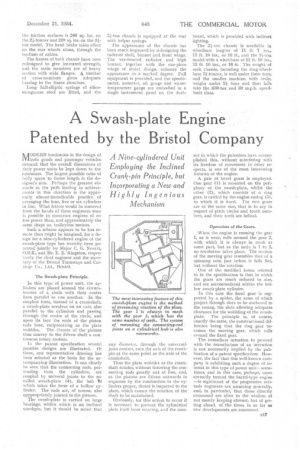Swash-plate Engine Patented by the Bristol Company
Page 31

If you've noticed an error in this article please click here to report it so we can fix it.
ISI/IODERN tendencies in the design of lifiboth goods and passenger vehicles demand that the overall dimensions of their power units be kept down to the minimum. The largest possible ratio of body space to frame length is the deeigner's aim. Perhaps the greatest obstacle in the path leading to achievements in this direction is the apparently almost-ineradicable practice of arranging the four, five or six cylinders in line. What fetters would be removed front the hands of -these engineers were it possible to construct engines of no less power. than, and approxima ielythe same shape as, frolleybus"motors.
Such a scheme appears to be less remote than might be imagined, for a design for nine-cylindered engine of the swath-plate type has recently been patented jointly by Major C. G. Nevatt, 0.13.E:, and Mr. E. E. Kingston, respectively the chief engineer and the secretary of the Bristol Tramways and Carriage Co.; Ltd., Bristol.
The Swash-plate Principle.
In this type of pc.wer unit, the cylinders are placed around the circumference of a circle with their , centre lines parallel to one another. In the simplest form, instead of a crankshaft,
swash-plate revolves on an axis, also parallel to the cylinders and passing through the centre of the circle, and upon its face the ends of the piston rods bear, reciprocating as the plate wobbles. The thrusts of the pistons thus convey to the driven shaft a continuous rotary motion.
In the patent specification several possible designs are illustrated. Of these, one representative drawing has been selected as the basis for the accompanying illustration. It can clearly be seen that the connecting rods, protruding Irani the cylinders, are coupled by univeral joints to the socalled seva.sh-plate (4), the hub tf which takes the form of a hollow cylinder. The rods are, of course, also apppropriately jointed to the pistons.
The swash-plate is carried on large hearings, within which is an inclined crankpin, but it should be noted that
any diameter, through the universaljoint centres, cuts the axis of the crankpin at the same point as the axis Of the crankshaft.
Thus thy plate wobbles as the crankshaft rotates, without throwing the connecting rods greatly out of line, and, as the pistons are driven outwards in sequence by the combustion in the cylinders proper, thrust is imparted to the plate, which causes the rotation of the shaft to be maintained.
Obviously, for this action to occur it is necessary to prevent the cylindrical plate itself from rotating, and the man
ner in which the patentees have accomplished this, without interfering with its freedom of movement in other respects, is one of the most interesting features of the engine.
A pair of bevel gears is employed. One gear -U) is mounted on the periphery of the swath-plate, whilst the other (2), which consists of a ring gear, is carried by the engine casing (3), to which it is fired. The two gears are of the same size, that is to say in respect of pitch circles and tooth numbers, and their teeth are helical.
Operation of the Gears.
When the engine is running the gear 1, as it were, rolls around the gear 2, with which it is always in mesh at some part, but as the ratio is 1 to 1, 110 revolution takes place. Tire motion of the moving gear resembles that of a spinning coin just before it falls fiat, but without the rotation.
One of the modified forms referred to in the specification is that in which the gears are much reduced in -size, and arc accommodated within the hollow swath-plate cylinder.
In this case the fixed gear is supported by a spider, the arms of which project through slots to be anchored to the casing, the slots allowing adequate elearance for the wobbling of the swashplate. The principle is, of course, exactly the saute, the constructional difference being that the ring gear becomes the moving gear, which rolls around the fixed gear.
The immediate intention to proceed with the manufacture of an invention is not necessarily implied by the publication of a patent specification. However, the fact that this well-known company is exhibiting such a degree ol interest in this type of power unit—sometimes, and in this case, perhaps, more correctly termed the barrel-type engine
sign ficant of the progressive attitude engineers are assuming generally, and, in particular, that those directly concerned are alive to the wisdom of not merely keeping abreast, hut of getting ahead, of the times in so far as new developments are concerned.




























































































